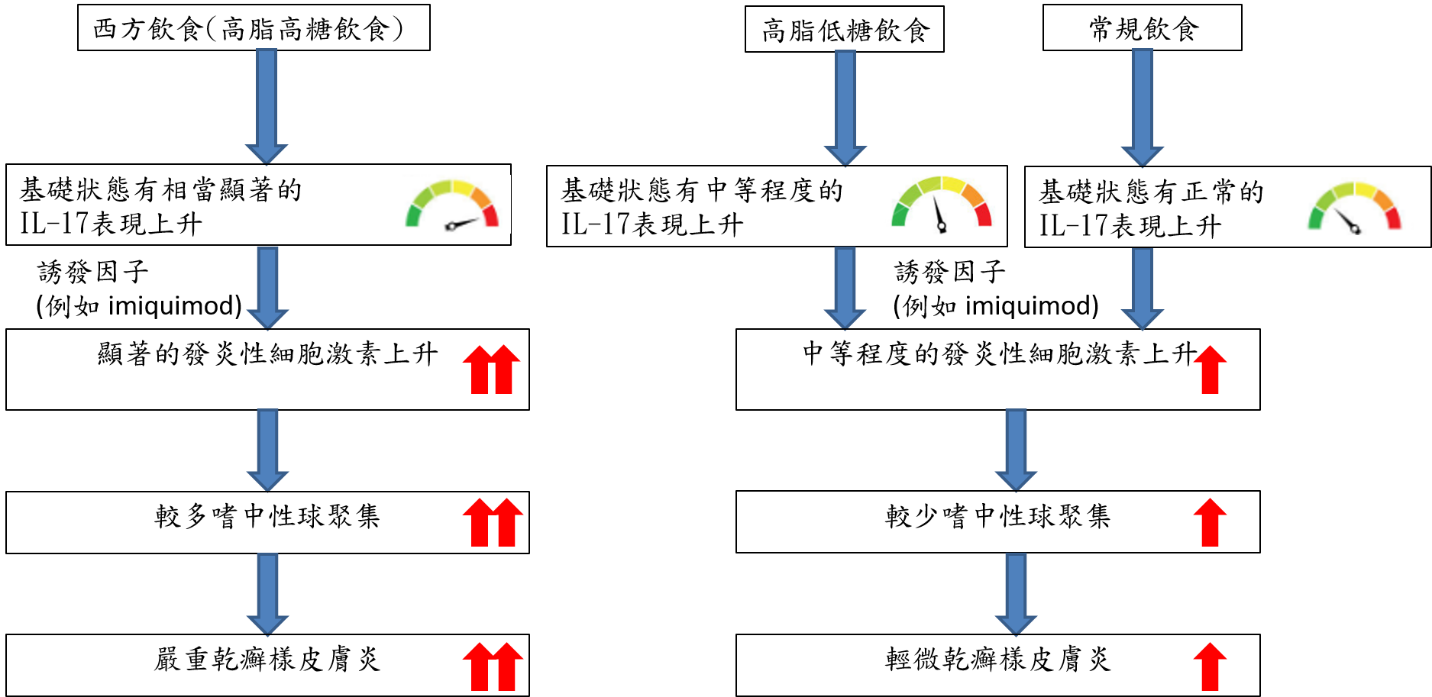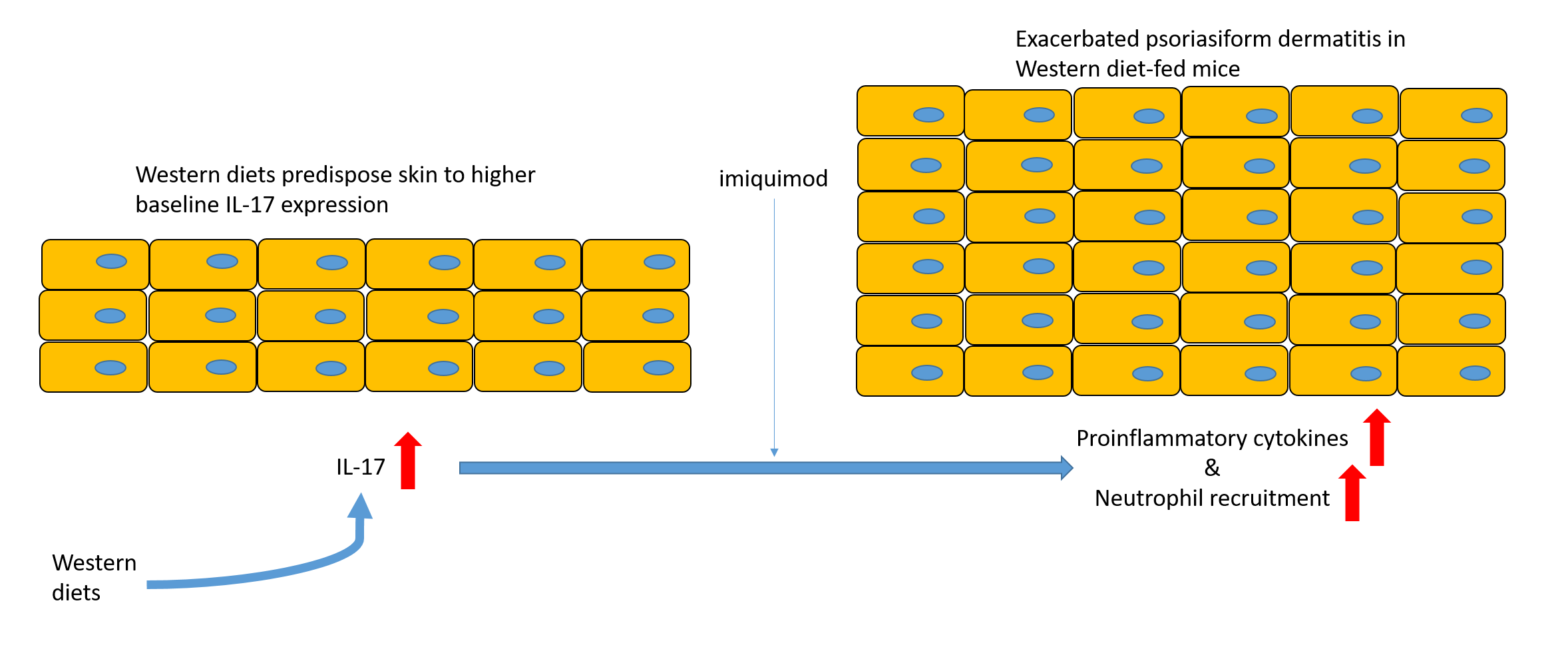乾癬介紹
乾癬是一常見的免疫調節發炎性疾病,特徵是皮膚有帶皮屑的紅色斑塊,並且常合併其他疾病如關節炎和心血管疾病。乾癬的成因和多種基因與環境因子有關,本研究團隊和加州大學戴維斯分校合作,致力於研究飲食對乾癬的影響。
肥胖、飲食和乾癬
肥胖和乾癬的相關性已廣為人知,肥胖會惡化乾癬,肥胖的病人減重之後則會改善乾癬。然而,飲食中的脂肪和糖(例如蔗糖),都會引發肥胖,一般人常接觸到的是西方飲食(Western diet,WD),這種飲食不只是攝取過多脂肪,也會從含糖飲料等來源攝取過多的糖。另一方面,探討肥胖和疾病關係的動物實驗,常常使用脂肪含量高但含糖量正常的配方(以下簡稱高脂飲食,high-fat diet,HFD)來誘導肥胖,本研究主要是想比較西方飲食和高脂飲食,在同樣會誘導肥胖的前提下,對乾癬性發炎的影響是否有所不同。
西方飲食、高脂飲食和乾癬
實驗設計上,將小鼠分成四組,分別餵食WD、control diet(CD,即WD的對照組配方)、HFD、low-fat diet(LFD,即HFD的對照組配方),在餵食小鼠三個月後,在耳朵塗抹imiquimod cream連續五天以誘導乾癬性皮膚炎,期間測量小鼠兩耳的厚度作為發炎水腫程度的指標。塗抹imiquimod cream滿五天後,取耳朵觀察組織變化,並作RT-qPCR和組織染色檢視乾癬相關的發炎因子變化。
餵食小鼠滿三個月後,HFD組的小鼠體重顯著高於其他三個組別,換句話說,食用HFD配方的小鼠肥胖程度較食用WD配方的小鼠嚴重,然而,經過imiquimod cream塗抹五天去誘導乾癬性發炎,WD組和HFD組相比,WD組小鼠在第四天後耳朵水腫程度較嚴重,組織學的檢視也發現,WD組小鼠發炎細胞如嗜中性球浸潤程度較嚴重,且Munro microabscess的密度也較高,用RT-qPCR檢視發炎因子的表現,也發現WD組的IL-17A、Ly6g、IL-6等表現顯著較HFD組高。
結論: 西方飲食誘導乾癬,食物中的高糖組成可能是一大關鍵。
綜合所述,在這個實驗所用的配方,雖然HFD較WD更會誘導肥胖,但是在小鼠imiquimod誘導乾癬性發炎的模式中,反而是WD組的乾癬性發炎較嚴重,依據此發現,對於乾癬病人的衛教可能不只要注意體重的控制,也要避免攝取過多糖類。將來需要更多的轉譯醫學研究和人類資料庫研究來驗證此實驗結果。

圖說: 西方飲食(高脂高糖飲食),相較於高脂低糖飲食和常規飲食,會引發較多的IL-17細胞激素表現,此細胞激素對乾癬性發炎扮演重要角色。當遇到誘發因子,例如imiquimod藥膏,接受西方飲食的小鼠會有顯著的發炎性細胞激素表現增加,也會有較多的嗜中性球聚集,如果和接受高脂低糖飲食或常規飲食的小鼠比較,接受西方飲食的小鼠會有較嚴重的乾癬樣皮膚炎,顯示西方飲食中的高糖成分對乾癬性發炎扮演重要角色。
Introduction of psoriasis
Psoriasis is a common, immunologically mediated, inflammatory disease characterized by scaly erythematous plaques on the skin and have comorbidities such as arthritis and cardiovascular disease. Pathogenesis of psoriasis involves polygenic predisposition and multiple environmental factors. Our team has collaborated with University of California Davis to investigate the effects of diets on psoriasis.
Obesity, diets, and psoriasis
The relationship between obesity and psoriasis is well known. Obesity exacerbates psoriasis while body weight reduction ameliorates psoriasis. However, both fat and sugars (ex. sucrose) induces obesity, and general people more often eats the Western diet (WD, high-fat and high-sugar content), which not only contains excessive fat but has excessive sugars from sugary drinks. On the other hand, the high-fat diet (HFD, high-fat and normal sugar content) is also used in animal experiments to investigate the relationship between obesity and disease. In this research, we aim at investigating if there is difference in psoriasiform inflammation between WD and HFD, both induce obesity.
WD, HFD, and psoriasis
For study design, mice were classified into four groups based on the diets: WD, control diet (CD, a control recipe of WD), HFD, low-fat diet (LFT, a control recipe of HFD). After feeding them for 3 months, we applied imiquimod cream on ears of mice for 5 consecutive days to induce psoriasiform dermatitis, and measure ear thickness as an indicator of inflammation during the course. After applying imiquimod cream for 5 days, mice were sacrificed and their ears were harvested to examine histological change, RT-qPCR and immunohistochemistry specific to psoriasis-related inflammatory mediators.
After feeding for 3 months, mice fed with HFD had significantly more body weight than other groups. This is, mice fed with HFD had more severe obese than mice fed with WD. After applying imiquimod cream for 5 consecutive days to induce psoriasiform dermatitis, however, mice fed with WD had more severe ear swelling after day 4. Histological analysis also demonstrated that mice fed with WD had more neutrophils and higher density of Munromicroabscess as well as higher expression levels of IL-17A, Ly6g, IL-6 than mice fed with HFD.
Conclusion: WD induces psoriasis, and the high-sugar content may play a crucial role.
Taken together, while HFD induced more obesity than WD in these recipes, it was WD group that had more severe psoriasiform inflammation in terms of the murine imiquimod model. According to this finding, health education for patients with psoriasis should not only focus on body weight control but avoid excessive sugar intake. Further translational medicine investigation and human database research are need to verify these experimental results.


